Dubai
Dubai is in equal measures absurd as it is entertaining.
With its mix of modern and unparalleled exciting activities to try it and its seemingly endless desire to have the biggest, widest, tallest or largest everything to gawp at; it’s place as a playground for the world’s tourism industry is growing by the day.
So, I’ll start this blog with an honest comment. With the above in mind, Dubai and the United Arab Emirates were never that high on my list of places to visit as I felt it would be like living in some sort of artificial environment.
You may, therefore, ask the reasonable question of me which is, why go if you’re not that attracted to it?
Again, if I continue to be honest, this visit was only really meant to be a tag-on to my wife (Holly) and I’s honeymoon plans in the Seychelles. Basically, we couldn’t get direct flights to and from the UK to the Seychelles so needed somewhere, “nearby” to stop.
Dubai quickly bacame that stop.
Initially, it was only going to be a layover. However, after doing a bit of research into what we could do in Dubai, we ended up booking five nights. And I’m so glad we did!
Going back to my original comment that Dubai is in equal measures absurd as it is entertaining, I still stand by this view. Everything presented to us has been created for a purpose, and that purpose is to draw people from all over the world to visit and spend time – and money – in the UAE.
So lets have a look at what made Dubai the city it is today.
The city itself rises like a mirage from the Arabian desert and its shiny complexion and towering buildings have captivated the world with its grandeur and modernity.
Yet, behind its towering skyscrapers and extravagant developments, that everyone is so familiar with today, also lies a fascinating history that traces back centuries.
Dubai’s roots can be traced back to the third millennium BCE when it was a small fishing and trading settlement. Archaeological discoveries suggest that the region had thriving communities engaged in pearl diving, fishing, and trading with neighbouring civilisations. Traders from Mesopotamia, Persia, and the Indian subcontinent frequented the shores, laying the foundation for Dubai’s future as a trading hub.
In the 18th century, Dubai’s strategic location along the ancient trade routes between Europe, Asia, and Africa propelled its growth. The Bani Yas tribe, led by the Maktoum family, established Dubai as a vital port for maritime trade. It became renowned for its pearl industry, attracting merchants from across the globe. Dubai’s natural harbour, known as the Dubai Creek, became a bustling centre of commerce, with merchants trading in textiles, spices, and precious metals.
In the early 19th century, Dubai came under the influence of the British Empire before the leadership of Sheikh Rashid bin Saeed Al Maktoum, who ascended to power in 1958, transformed Dubai’s destiny.
It was from here that, in the late 20th century, Dubai embraced a bold vision to become a global business and tourism destination. The establishment of Jebel Ali Port and the leadership of Sheikh Mohammed bin Rashid Al Maktoum – the current ruler of Dubai – transformed the city into a world-class metropolis. Dubai’s relentless pursuit of excellence resulted in awe-inspiring architectural marvels, including the Burj Khalifa, Palm Jumeirah, and the Dubai Mall.
Today, Dubai stands at the forefront of technological advancements and has become a global hub for entrepreneurship and innovation.

So, what does a first-time visitor to Dubai need to know before travelling to the United Arab Emirates?
Dubai and the United Arab Emirates have become increasingly popular tourist destinations in recent years, with its unique offering of the blend of modernity and luxury with traditional Arabian charm.
The first thing to consider is the weather. If like we did, you travel in May then you’ll be visiting Dubai in its transition from spring to summer. During this time the weather tends to become increasingly warm and dry.
Temperatures can range – on average – between 30°C and 40°C (86°F to 104°F) during the day, with cooler evenings around 20°C to 25°C (68°F to 77°F).
It’s advisable to pack lightweight and breathable clothing, such as cotton or linen, along with a hat, plenty of sun lotion, and sunglasses to protect yourself from the strong sun.
The next thing to consider is the local currency.
The official currency of the UAE is the Dirham (AED). The AED is widely accepted throughout Dubai and the UAE, and you can also use major credit cards in most establishments. ATMs are readily available, allowing you to withdraw cash conveniently. At the time of writing £1 sterling would get you around 4.50 AED.
It’s also worth noting that Dubai is not a cheap city. You can easily expect to spend a significant amount of money each day so I’d suggest plan in advance what you want to do, book tickets, and pay in advance (where possible) also so you can budget for your time in the UAE more accuratley.

Another thing to consider is the power points.
Conveniently for British travelers, the plug type for Dubai and all places within United Arab Emirates is plug type G, which is the plug that has three rectangular pins in a triangular pattern that we use in the UK. Dubai operates on a 230V supply voltage and 50Hz.
The next thing to think about is the time difference.
Dubai and the UAE operate on Gulf Standard Time (GST), which is three hours ahead of the UK. So while you’ll lose three hours during your journey to Dubai, you’ll gain them back upon your return to the UK.
Another thing to note is the language.
Arabic is the official language of the UAE, but English is widely spoken, especially in major tourist areas, hotels, restaurants, and shopping malls. This makes communication relatively easy for English-speaking visitors.
However, learning a few basic Arabic phrases and greetings can be a nice gesture and can help you connect with locals on a more personal level. Simple words like hello (mrhban), goodbye (mae alsalama), please (law samaht) and thank you (shkran lak) can go a long way.
The final thing to remember is that the UAE follows Islamic traditions, and it is important to respect local customs while visiting.
Visitors are asked to dress modestly when visiting religious sites or more conservative areas (particularly true if you go to Abu Dhabi – more on that later on). Furthermore, public displays of affection are frowned upon, and it’s advisable to avoid drinking alcohol in public places, except in licensed venues.
That being said, when spending time in Dubai, there seemed to be little notice paid of some of this and numerous people would wear revealing outfits while in public. Basically, just pay attention to the setting you’re in and act and dress accordingly.
Getting there
Given it’s rise in popularity, there are an ever increasing number of flights from the UK to Dubai these days.
Multiple airlines fly the routes from a variety of UK airports including London Gatwick, London Heathrow, London Stansted, Glasgow, Manchester, Birmingham and Newcastle upon Tyne. Flight operators include British Airways, Virgin Atlantic and Emirates.
So when we were planning our trip to this bustling metropolis, Holly and I had plenty of options to choose from. However, with flight times – as well as our desire to also travel onwards to the Seychelles – we plumped for the impressive Emirates who could take us for all legs of our journey.
First thing to note is that this is not a cheap option. When it comes to booking an Emirates flight from London to Dubai in May time (the month we travelled), several factors influence the cost, including the time of booking, availability, and class of travel.
On average, a return economy class ticket can range from £400 to £700 per adult (which increases further if you want to book a specific seat allocation in advance or take extra luggage.
This was the first time either of us had flown with Emirates and we’d heard nothing but positive things about it and, I’ll be honest, it did live up to its billing.
For the flight from London Gatwick to Dubai and the return journey back to London Heathrow we were well fed and had a good selection of drinks to choose from which we were able to enjoy while watching our choices from a huge selection of films and tv shows (I managed to cram the whole series of Dexter New Blood into the combined flights).
The seven hour flight time went very quickly, and before we knew it we were touching down in the UAE to start our adventure.
The first part of that adventure was navigating the huge Dubai International Airport. This behemoth of an airport is not only one of the world’s largest, it’s also one of the world’s busiest and most advanced.
It has three terminals conveniently named Terminal 1, Terminal 2, and Terminal 3 with the latter being the main hub for Emirates flights.
After we disembarked our flight we started the walk to immigration. Here – as a UK visitor – we only needed to present our passports as buying a visa in advance was not required. The immigration procedures were pretty efficient and we soon found ourselves with a shiny new stamp in our passports welcoming us to the United Arab Emirates.

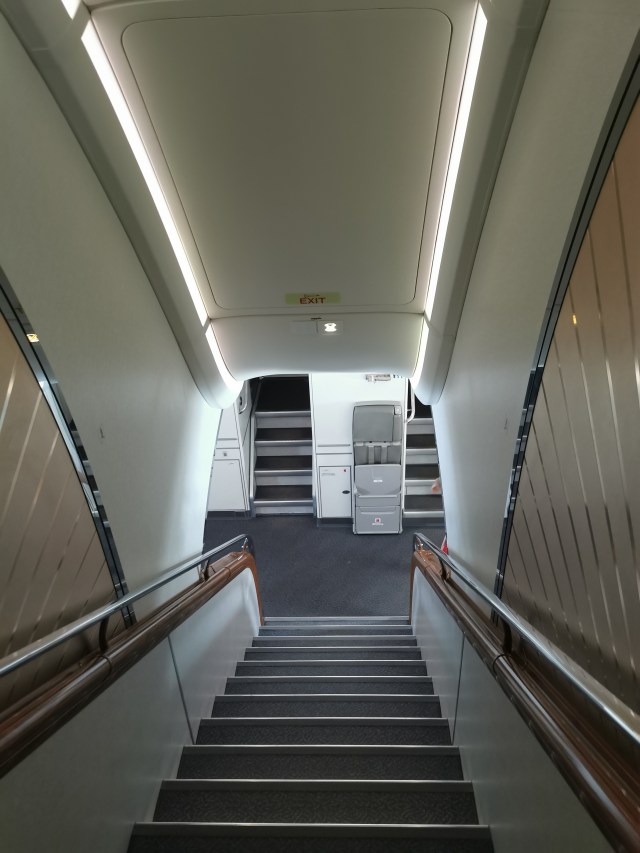
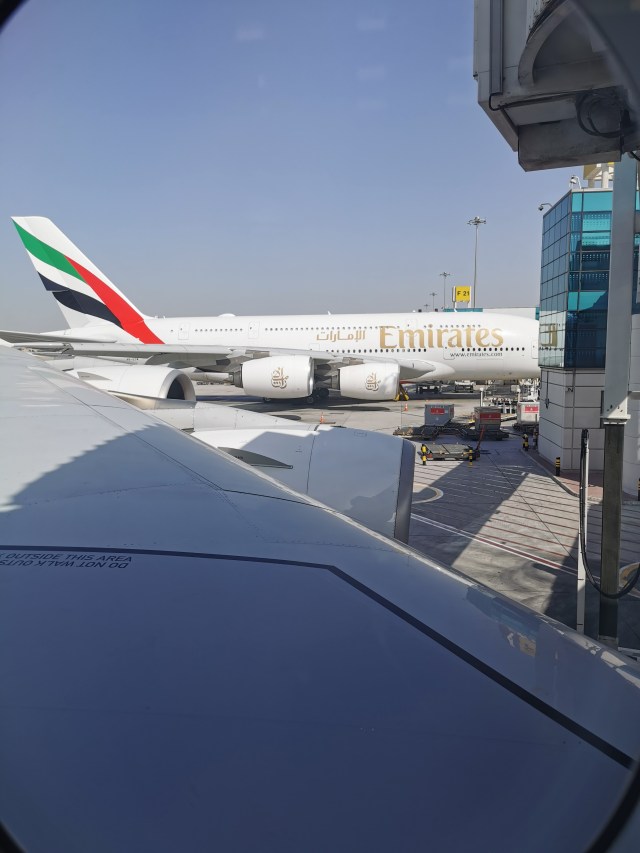

Where to stay
Dubai, as you’d expect, has a plethora of hotel options and AirBnB-style apartments for visitors to utilise during a stay.
Numerous hotels in the city are world-renowned and come with the price-tag to match. While these were out of our budget, we did still want to say somewhere that offered us something special.
When we were looking at places to stay in Dubai, we decided that we wanted to be around the Dubai Marina area. From here, we felt we’d put ourselves in a good position to get easy access to the places we wanted to go to and visit.
So, with that in mind, we selected the Jumeirah Living Marina Gate.
It’s worth noting that the Jumeirah Living Marina Gate is more than just a hotel. There are two entrances to the building – which is located on Al Khayay Street right next to the Dubai Marina – with one on the left as you face the entrances for permanent resident and the other on the right for visitors.
Booking in advance we paid a fairly reasonable 4,732 AED in total (around £1,020) for our five-night stay in May; although prices are likely to vary depending on the style of room you select.
For our stay, Holly and I opted for an Executive Studio (which is their cheapest room); but even that is more than comfortable and extremely spacious.
Having arrived in the stylish reception area and checked in (after a rather long-winded attempt by the staff member behind the counter to up-sell us a bigger room), we made our way up to the 14th floor of the building.
Navigating the corridor, we found our room at the end of a hallway and let ourselves in.



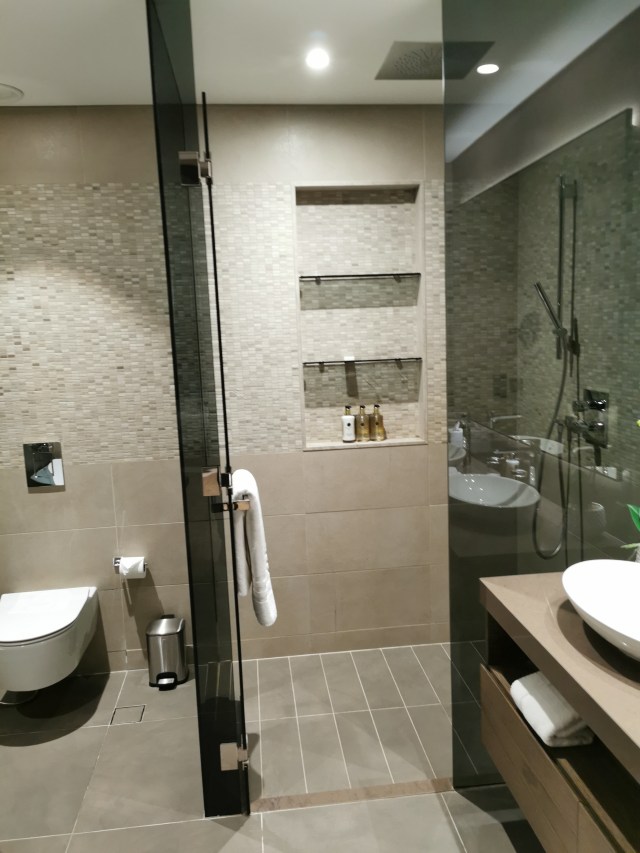
Inside we were greeted by floor-to-ceiling windows, a separate living area, a fully equipped open-plan kitchen, a great sized bedroom, and a huge bathroom with separate waterfall shower and large bathtub.
To make matters better, because this trip was part of our much belated honeymoon, the staff had left us a lovely cake and fruit for us to enjoy. A really nice, generous touch.
The room also had access to a small balcony area which was just big enough for two people to sit out on. From our spot on the 14th floor, we could see out across part of the city and marvelled at the skyscrapers piercing the sky all around us.
Elsewhere in the hotel, we were also able to make use of the various facilities on offer which included a beautiful infinity pool on the rooftop of the seventh floor – where we enjoyed a number of refreshing swims while overlooking the bustling Dubai Marina below – as well as a sauna and steam room in each of the male and female changing rooms.



Getting around
The first thing to state is that Dubai is not a city that has been built with the pedestrian in mind! Making even the shortest walk here (as the crow flies) can be a tricky affair that takes you miles out of your way in order to get the shortest distance.
To give you an idea, Holly and I walked for over 45 minutes to get about 2km back to our hotel from the escape game we played. This was due to, despite the short distance, there was a great big multi-lane highway in the way and very few places to cross it safely!
The other reason to avoid walking is that during the day time, the heat is intense and cover can be limited. This doesn’t make for a pleasant experience – especially if you enjoy as pale a complexion as myself!
So what do you do?
Well my prime suggestion is download the Careem App. Similar to Uber, Careem is the primary taxi app used in the UAE (and possibly other Middle-Eastern countries as well).
Holly and I made regular use of the app to get around the city to and from our hotel. When we booked a ride to take us somewhere from the hotel we waited for literally two minutes before a car turned up. The service was remarkable! Further to that, pretty much every Careem was a really good car making the rides very comfortable. It was also my first ever trip in a Tesla which resulted in me struggling to open the door as they had abandoned the use of the simple handle system on that particular model in place of a button that I just couldn’t, for the life of me, find!
The app itself is very easy to use once you’ve downloaded it and set-up an account. You can add a credit card to the app or you can still pay in cash if you wish at the end of a journey.
One of the standout features of Careem is its pool of professional and experienced “captains” – or drivers to you and me. These individuals are well-versed with Dubai’s roads and traffic patterns, ensuring we always reached our destination promptly. Furthermore, they are courteous, ensuring a pleasant and comfortable ride throughout. Many also imparted their own wisdom on us about the buildings we were passing making the experience an educational one as well.
When it comes to pricing, Careem ensures transparency and competitive rates. Fare estimations are provided upfront, eliminating any surprises at the end of a journey. The app calculates fares based on distance, duration, and the selected vehicle category.
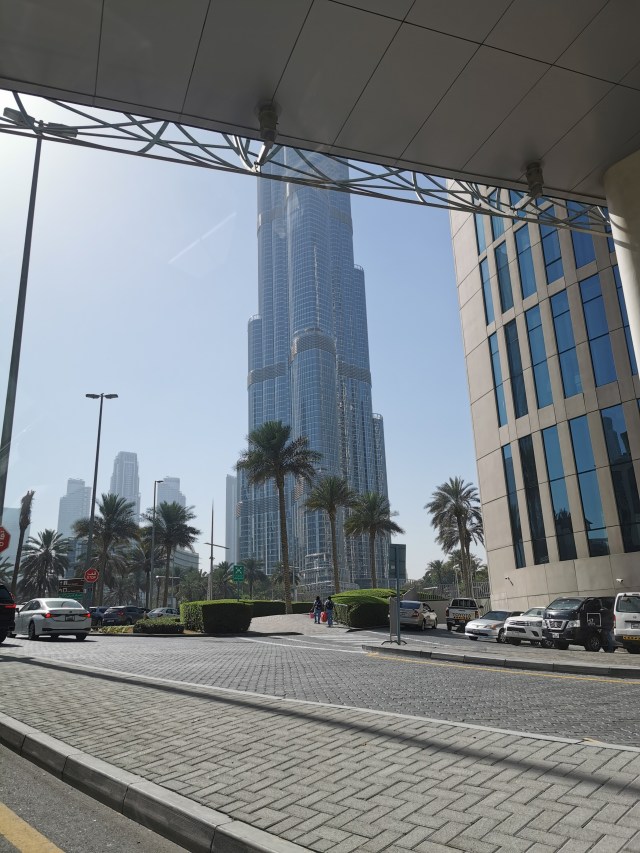
The second best way to travel in Dubai is by using the city’s Metro line.
At the time of writing, the Dubai Metro is divided into two lines, the Red Line and the Green Line and covers popular destinations such as Dubai Marina, Downtown Dubai – including the Burj Khalifa and Dubai Mall – Dubai International Airport, and the Expo 2020 site.
With convenient transfers to other modes of transport, including buses and trams, the metro offers seamless connectivity and simplifies travel for both residents and tourists.
Trains are equipped with spacious, air-conditioned compartments, providing respite from the city’s scorching heat. Slightly strangely, for a person from the west, there are also dedicated areas for women and children onboard the train that “ensures a safe and comfortable journey for all”.
The Dubai Metro is renowned for its punctuality and efficiency. The trains operate with impressive precision, adhering to schedules and minimising delays. This reliability is invaluable for both residents rushing to work and tourists exploring the city, ensuring that they can plan their day with confidence and make the most of their time in Dubai.
Holly and I didn’t make as much use of the Metro as we first thought we would; only using it on the return journey for the one day we went to the far north of the city. If I’m honest, we probably should have used it more often as the Metro is extremely cheap – with tickets costing between 4 AED and 8.50 AED (around £1 to £2) per journey.
There is also the option to buy a one-day pass for the Metro – at a cost of 20 AED (about £4.30) for a Red Card or 40 AED (about £8.60) for a Gold Card. which may prove even more cost effective if you plan to make a few journeys during the day.
My view is to get the Dubai Metro Red Card. This option is primarily for those who need a temporary card and is ideal for visitors and tourists visiting the city and staying for more than three days.
All Dubai Metro tickets must be purchased in the form of a Nol card. No other payment form is possible for the Metro. A Nol card is like a credit card that holds either a balance or a specific season ticket for travelling on a lot of the public transport in Dubai including the Metro, buses and the tram. Once you have a Nol card you can top it up at stations, should you need to, using cash or credit cards.


Top sites
Dubai has so many things to do, ensuring you’re making the most of your time in the city is vital.
Therefore, the first stop on any itinerary for Dubai is the world-famous Burj Khalifa.
As soon as you enter Dubai you’ll notice skyscrapers everywhere. Most would be impressive enough on their own, but once the Burj Khalifa (or Burj for short) comes into view, they all pale in comparison.
Opened in 2009, the Burj has been (and still is at the time of writing) the tallest building in the world! Standing at a height 829.8m (2,722 ft, or just over half a mile) this steel and glass monster is a sight to behold.
Burj Khalifa was designed to be the centrepiece of a large-scale, mixed-use development that included 30,000 homes, nine hotels, three hectares (7.4 acres) of parkland, at least 19 residential skyscrapers, the Dubai Mall, and the 12-hectare (30-acre) artificial Burj Khalifa Lake.
The construction – which started in 2004 – saw the Burj smash numerous world records aside from the obvious one of being the tallest building. Some of the others it broke were the world’s longest travel distance elevators (504m), building with most floors (163) and the world’s highest restaurant (located on the 122nd floor at a height of 442m).
Our first sight of this enormous tower came on our airport transfer and – even from a distance – seeing the top of the building’s spire piercing the night sky was a magnificent sight to behold.
Getting to the Burj can be done in a couple of easy ways. You can either get a taxi (our choice) or you can get the Metro to Burj Khalifa/ Dubai Mall Metro Station.
The tower itself is situated next to the Dubai Mall and its viewing platforms are accessed from inside the giant shopping centre (which is – funnily enough – the the largest mall in the world).
After a bit of searching inside the Dubai Mall for the correct entrance to go to, we found our way to the ticket purchasing queues. I’d strongly suggest booking online before you travel to ensure you get a time slot that works for you. The risk is, if you wait until you are there, then the slots you want are already taken.
I will warn you now though; tickets for the Burj can be extremely expensive! Prices also vary depending on the time of day you visit.
There are a two main options you can take for your ticket purchase at the Burj. The first is tickets called “At the Top” which is a slightly misleading title. These tickets are the cheapest option with prices starting at 169 AED (around £37) per person. However, this ticket doesn’t give you access to all the observation decks and only permits you to access floors 124 and 125.
The second option (the one we selected), is called “At the Top, Burj Khalifa SKY”. This ticket gives you the access to both floors 124 and 125 but also the higher up (and quieter) observation deck on floor 148. Tickets here start at 399 AED (around £88) but this is for the times of day that are less popular. For our two adult tickets we ended up paying 558 AED (around £130) per person so we could go up at 10am before the huge crowds.
It’s a lot of money, but I’ll be honest, the experience at the Burj was worth every penny.



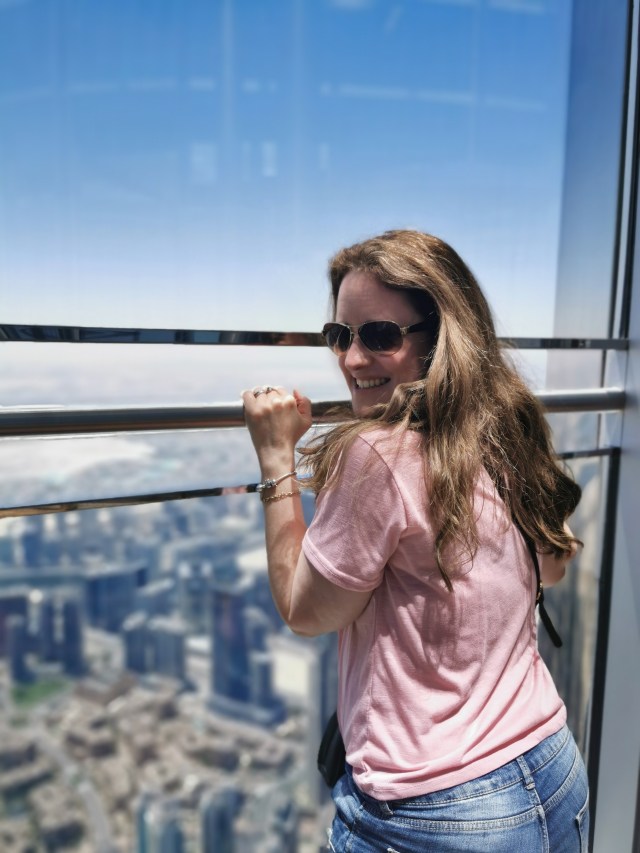
After arriving and showing our tickets, we were guided to a waiting area. Once inside we waited for around 10 minutes before our guide took us (and the rest of the guests) to the first lift.
This lift takes you from the ground floor up to floor 124 in just one minute! The force from the speed of this lift can be felt while you ride it and enjoy the visual effects on display.
When the doors open – if you’ve purchased a ticket for the 148th floor then you are guided to a further lift that whisks you up to that level in a matter of seconds.
As soon as the doors open you get your first glimpse of the jaw-dropping views on offer.
The joy we found from this ticket to this upper floor was that very few others seemed to have booked it. While there were a handful of people up with us, we managed to easily get two seats by the window to take in the views. Added to this, we were also treated to some delicious treats (dates and small cakes) as well as teas and coffees; all of which was complimentary as part of our ticket. The beauty was that this was not a rushed experience and each time we finished, someone came up and offered us more!
After eating and drinking our fill, we took in all the various sights the Burj had to offer. Looking down at the other skyscrapers that seemed so tall from street level, but so miniscule from our ivory tower.
The experience isn’t even restricted to staying inside, and – despite the scorching heat – we were able to go outside onto a platform (well protecting behind safety glass I’ll add) to soak in the feeling of standing half a mile in the air!
Once we’d made the most of our time here, we headed back to the lifts (via the small gift shop) and headed back down to the lowly 124th and 125th floors.
These floors were much busier and made us appreciate, all the more, having paid the bit extra to get the views we did from above. Still extremely impressive, we didn’t hang around too long here before heading down and out into the Dubai Mall.



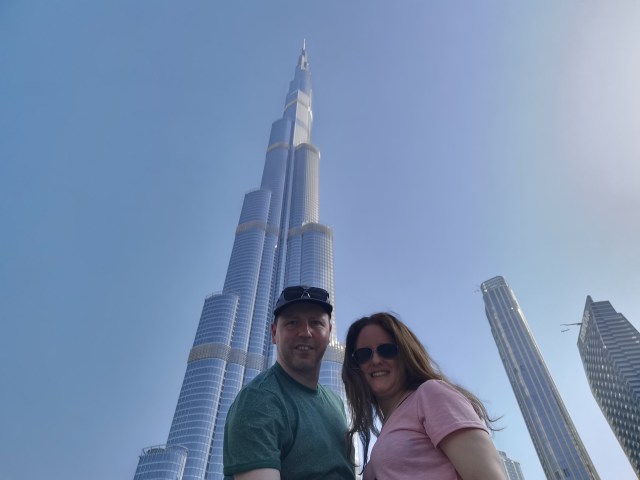
The next stop after coming down from the Burj kept us inside the massive Dubai Mall. Navigating the many walkways of shops we found ourselves in front of the huge glass window of the Dubai Aquarium and Underwater Zoo.
I would suggest purchasing your tickets in advance online beforehand as this cuts out that queue. We purchsed the All Access Pass tickets for 400 AED each (around £93) which wasn’t the cheapest ticket available but gave us everything we wanted to do.
For this price we got to skip the queue, access to the Aquarium Tunnel Underwater Zoo, a private behind-the-scenes tour, a visit to the Penguin Cove, a ride on the Underwater Observatory Submersible Simulator, a private glass bottom boat ride and access to feed some of the fish.


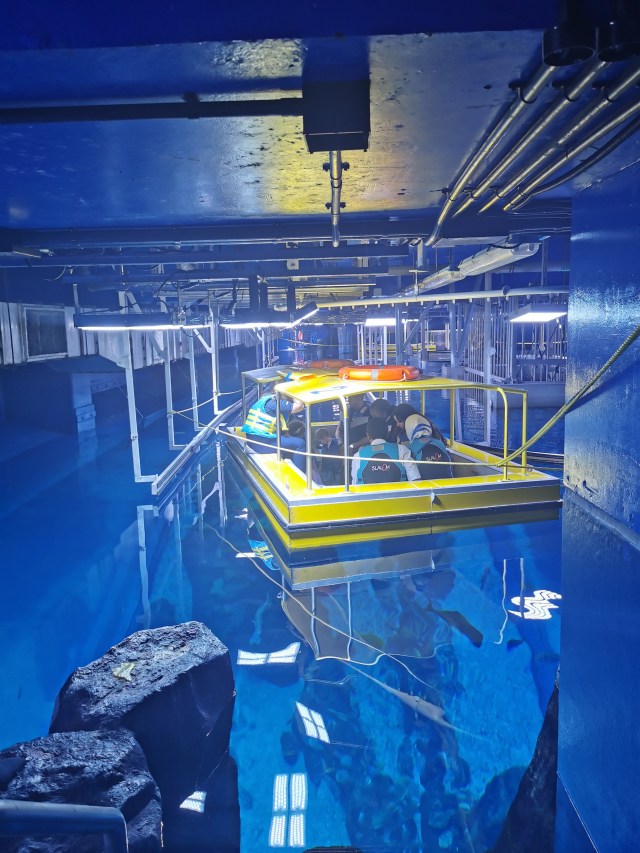

This front of the aquarium is visible from the main shopping centre and many people stop for photos in front of this giant tank’s window, which is home to numerous stingrays and large sharks!
Arriving at the entrance the first thing you get to do is get a closer view of the huge aquarium; but from inside its 48m long tunnel that takes you 11m under the surface! Looking up, sharks and rays swim overhead giving you an unparalleled view of this ginormous tank and its inhabitants.
The tank houses thousands of aquatic animals, comprising over 140 species. Over 300 sharks and rays live in this tank, including one of the largest collections of sand tiger sharks in the world.
After taking this short stroll you go up into the main body of the aquarium and underwater zoo.
While the main focus of the is the huge suspended aquarium (holding some 10 million litres of water) there are also plenty of other exhibits and animals to see inside including crocodiles and other reptiles and a variety of birds (some of which fly freely around the room with you).
Holly and I were pleasantly surprised by how engaging the aquarium and zoo were. We spent a number of hours looking at all it had to offer and really enjoyed feeding the fish from the top of the aquarium. However, for us, the glass bottom boat trip was a particular highlight and – as part of our ticket – we got a boat to ourselves so we were able to really get great views of all the marine life swimming below the surface.




Sometimes the best way to see the most famous sights in a city – or country – is to go to somewhere else nearby and look back at them. It could be argued that this is the case for the Burj Khalifa from the nearby Sky Views Observatory.
However, that would be an unfair representation of the Sky Views Observatory as it is home to one of the quirkiest attractions in the city itself.
The neighbouring skyscraper to the Burj – which is a short walk from the Burj Khalifa / Dubai Mall Metro station – is home to a short, yet extremely satisfying, glass slide that looks down at the city below from a height of 219.5m!
Having paid the very reasonable 25 AED (around £5.25) Holly and I took the lift to level 53 where we joined the short queue for the white-knuckle trip.
As we queued up we were treated to some spectacular views of the Burj Khalifa. Then, soon enough, it was our turn to ride.
Holly went first (which gave me a good opportunity to film her going down and screaming “weeee” as she did) before I sat atop of the glass and shuffled my way to the edge before taking the plunge down the slide (just having enough time to sample the views on offer).
The Glass Slide (which is a first for the Middle East) is a transparent tube that wraps around the tower’s exterior linking level 53 with level 52 below.
Specially manufactured in Germany, the Sky Slide is fabricated from 12m-long sheets of quadruple-laminated glass. Supported at the top and bottom only, the ride from floor-to-floor is completely uninterrupted, and provides amazing views of the city below.
The ticket we purchased was a one-time slide only ; an additional slide can be added for a further 25 AED. However, one go is probably enough.
The ticket does also include access to the glass walk experience (the Observatory) which is also a great place to grab some photos and look down at the city below.
While Holly and I only did the slide during our visit, there are other activities available for a variety of prices. This includes a meal at the tower’s restaurant or a go on the Sky Edge Walk (504 AED or £108) – a dare-devil exterior walk that encircles the 53 level providing those brave enough with a bird’s eye view of the city and Burj Khalifa far beneath their feet.
Needless to say – given my huge dislike of heights (or to be more specific, falling from them) this one wasn’t for me!

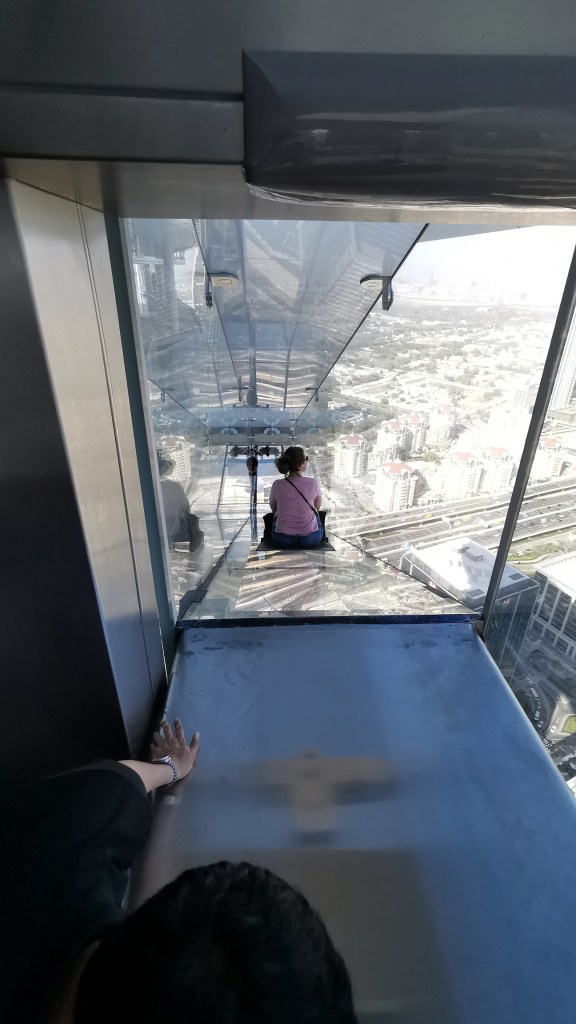


Back outside the Dubai Mall now, and right infront of the Burj Khalifa (honestly a lot of stuff is centred around this point), sits the stunning Dubai Fountain.
The Dubai Fountain stands out as a true testament to human creativity and engineering excellence.
Far from being just a fountain; this free attraction is a symphony of water, light, and music that enchanted visitors from around the world flock to witness.
The Dubai Fountain is a visual spectacle that stretches over 900 feet in length. Designed by the same team behind the renowned Bellagio fountains in Las Vegas, this engineering marvel features a series of powerful jets that shoot water up to a height of 500 feet, creating a dazzling display of water in motion.
What sets the Dubai Fountain apart is its ability to synchronise its movements with a carefully curated selection of music. The fountain’s intricate system allows it to dance to the rhythm, creating a harmonious blend of water, light, and sound.
The fountain’s jets are illuminated by a vibrant spectrum of colorful lights, enhancing the visual spectacle and adding an extra layer of enchantment to the experience. Witnessing the fountain’s performance against the backdrop of the glittering city skyline is an unforgettable sight that will leave you in awe.
The best time to see the show is as the sun sets over Dubai. Shows start every day in the evening at 6pm and go up to 11pm. Each performance lasts about five minutes and start on the hour and at half past the hour.
To ensure you get a good view – as we did – make sure you arrive just as one show ends and claim a spot at the front of the lake or on the nearby bridge overlooking the water.
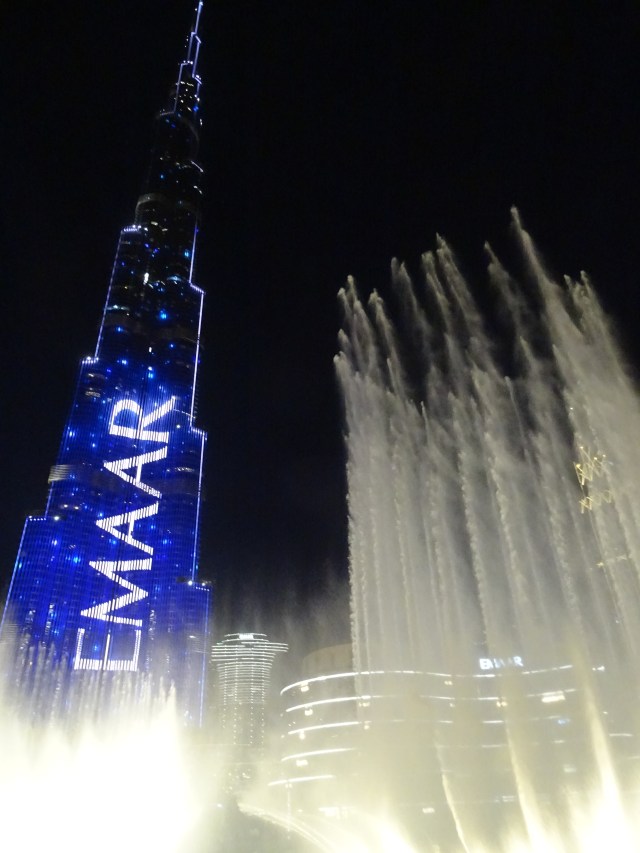


If you’re like us, and in a city (like Dubai) that offers a myriad of attractions then you want to cram in as many of them as you can during your stay.
Before heading out, we’d looked into a few options for a real fun day. Something that allowed us to be the big kids we are at heart. So what better place to go than to a water park!
There are a few options that presented themselves to us for this but chief among these marvels stood the magnificent Atlantis Aquaventure Waterpark; an aquatic paradise that promises an unforgettable adventure for both thrill-seekers and families alike.
Nestled within the iconic Atlantis, The Palm resort, this waterpark is a haven of excitement and relaxation where aquatic thrills and tranquility harmoniously coexist.
The main pull of this park are the rides and, by god, they are something special.
With over 100 different rides and slides, this park takes its place as the largest waterpark, by size, in the world.
From the nerve-wracking Leap of Faith, a near-vertical drop that propels riders through a transparent tunnel submerged in a shark-filled lagoon, to the heart-racing Poseidon’s Revenge, which plunges you down a trapdoor at incredible speed, the waterpark offers a plethora of adrenaline-pumping experiences.
Daredevils can also conquer the Aquaconda, the world’s largest water slide, or embark on the adventurous Tower of Neptune slides, twisting and turning through the mysterious Ziggurat structure.
Special mention also to my favourite ride; Shark Attack. This unique tube ride lets you experience a safari with a difference. Located in the park’s Tower of Neptune you slide down in a one- or two- person tube and emerge into an underwater lagoon filled with sharks and other sealife. The fibre glass tunnel you slowly float through allows you to enjoy 360-degree view of shark-filled lagoon.
It’s not all about the rides, however.
Beyond the adrenaline-inducing attractions, Atlantis Aquaventure Waterpark also caters to those seeking relaxation and tranquility. The pristine private beach, with its soft golden sands and mesmerising views, invites visitors to unwind under the warm Dubai sun (something that’s not for me with my pale skin, but plenty of other people seem to enjoy).
Visitors can also find solace in the refreshing wave pools, drifting along the lazy rivers, or renting a private cabana helping them indulge in a haven of calm amidst the bustling park.
Now the less fun bit. The price.
A day pass to the park costs 315 AED per adult (around £68). On top of that, you are likely to need to hire a locker at 50 AED (around £11) and a towel at 35 AED (around £8).
To make matter simple during our visit, we also paid in advance for a meal-deal combo at 70 AED per person (around £15). This meant that we didn’t need to keep going back to the locker to get credit cards or money. In total, our day’s visit for two adults cost us 930 AED (around £200). Not cheap, but we had an amazing day and enjoyed all aspects of the park.
One tip to give you. The floor in the park (outside of the water parts) gets extremley hot. Therefore take full advantage of the water socks they hand out to you for free near the entrance of the park as this makes walking around a lot more comfortable.

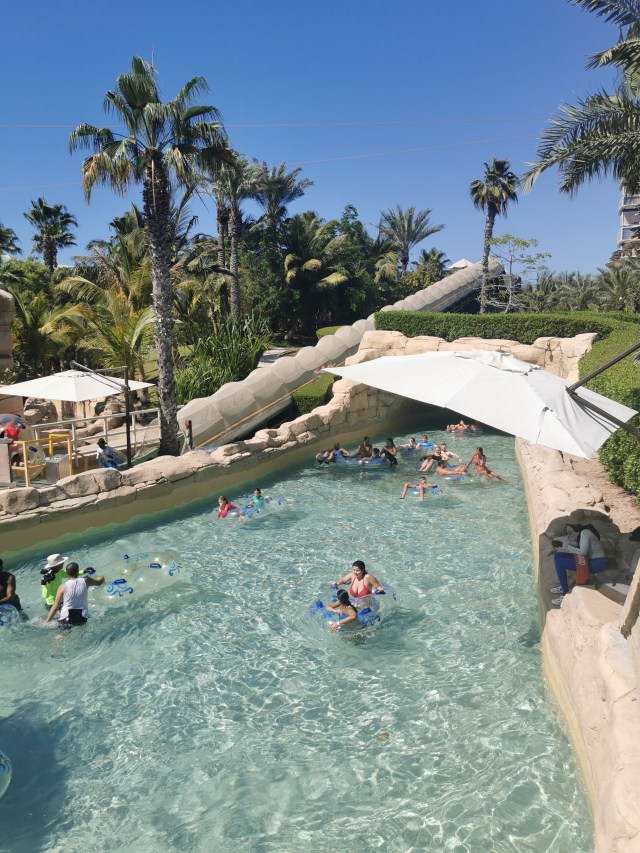

The city may be best known for its sky-piercing buildings but another intreguing site that visitors should see is the Dubai Frame.
Entrance to the Dubai Frame costs just 50 AED (around £11) per person and gives you great shots up at the imaginative piece of architecture which is located inside the parametre of Zabeel Park at the far north end of Dubai.
The 150m high Dubai Frame is an engineering marvel that connects the city’s vibrant past with its visionary future. To one side of the frame you have the historic – much lowering-lying past while a quick glace to the other sees your eyes thrust skywards at the city of the future.
Shaped like a colossal picture frame, this landmark is made of glass, steel, and reinforced concrete, reflecting the city’s modernity and innovation.
Upon entering the Dubai Frame, Holly and I were transported back in time. The ground floor museum took us on a captivating journey through Dubai’s humble beginnings as a fishing village, its rapid transformation into a global metropolis, and its ambitious plans for the future. Engaging exhibits, multimedia presentations, and interactive displays paint a vivid picture of Dubai’s history, showcasing the city’s resilience and determination.
As we ascended the elevator to the upper level of the frame our anticipation built. Stepping out onto the Sky Deck, a breathtaking panorama of Dubai unfolded before our eyes.

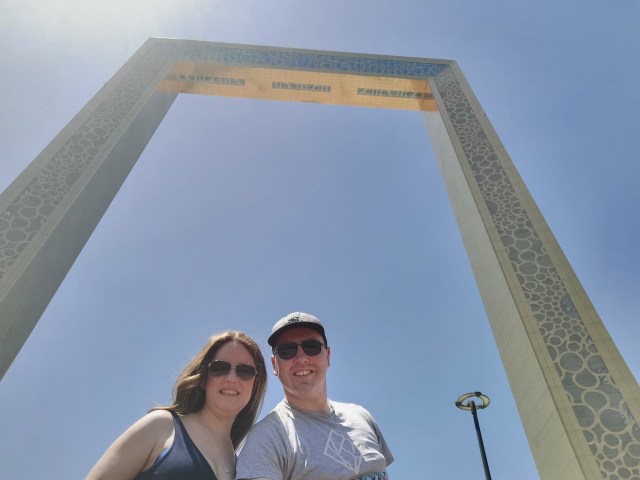

On one side, we had the hustle and bustle of modern Dubai, with towering skyscrapers, futuristic architecture, and glistening cityscapes stretching as far as the eye could see. On the other side, there was the traditional charm of Old Dubai, with its historic neighborhoods and narrow alleyways that harken back to a bygone era.
The upper level of the Dubai Frame also offers the chance to look down at the ground below via it’s Sky Walk. Encased in a glass-floor bridge, you feel like you’re walking on air as you stroll between the two vertical towers, peering down at the cityscape below. This heart-pounding adventure provides a unique perspective, allowing you to appreciate Dubai’s stunning skyline from an entirely new angle.
The one downside we found was that the sheer size of the Dubai Frame and the lack of space to really stand back in the park means you can’t get a photo of the city backdrop within the confines of the frame. To get a slightly better angle, for a photo we left the park after our visit and crossed the large Sheikh Rashid Road to stand in front of the large tourist gift shop (called Gifts Village). From there we were able to get a better view (although we still found that most of the shot is filled with empty sky).
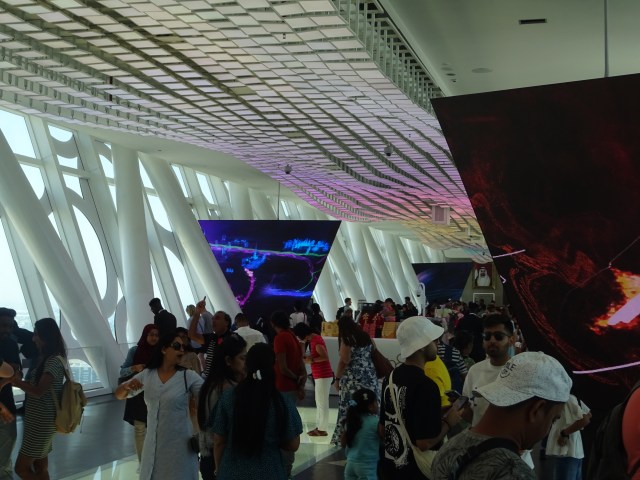
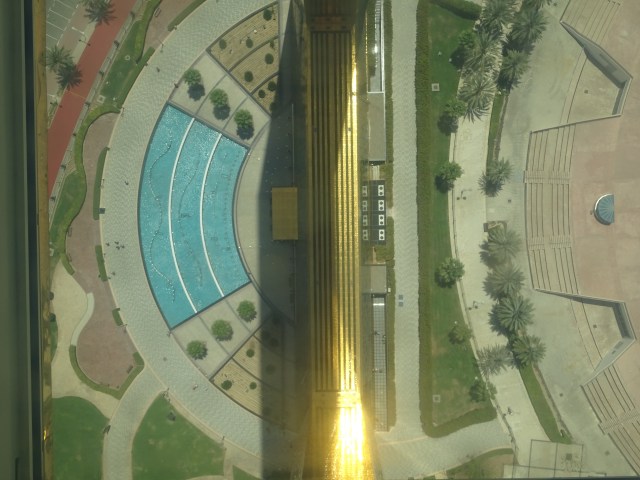
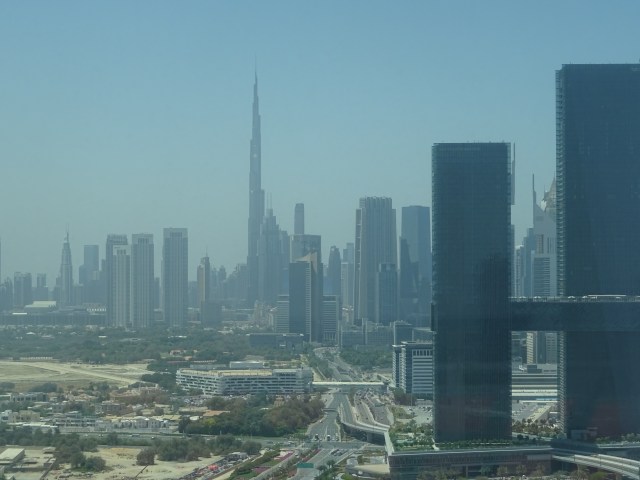

As any reader of this blog will know, I couldn’t visit a new city without playing an escape game. And our experience at Phobia Escape Games was extremely enjoyable.
Spread across two locations (both near to each other) Phobia Escape Games has a range of rooms that are challenging and fun to play which costs 320 AED (around £70) for two players.
Each Phobia Escape Room game is meticulously crafted to create a realistic and captivating environment. The detailed settings, captivating sound effects, and convincing scenarios work together to create an atmosphere that feels incredibly real.
Phobia Escape Room offers a wide range of themes, ensuring there’s something for everyone.
Our game (Battle of the Wizards) was located in their shop at the base of Jumeirah Bay X1. With Holly’s love of all things Harry Potter and this rooms less-than-subtle nod at the series, this was the obvious choice for us.
Meeting the games hosts inside the shop, we were promptly shown to our game room and told the premise of the story.
The room was fun and had some good touches. However, the hint system maybe could be improved as hints were automated and when we got very stuck at one point the same clue was just played until the game master came on the microphone to advise us where we were going wrong.
Despite that minor hiccup, 52 minutes after entering the game, we had completed it! Another tick on the success sheet!




The final suggestion for a most see is actually outside of Dubai. Some may not realise that Dubai isn’t the capital of the UAE, so a day trip south to the country’s official capital city is a must.
This nine-hour trip can be done on the Abu Dhabi Sightseeing Tour.
To book this trip we used Get Your Guide in advance of arriving in the country. This trip cost us a total £195.64 but it was worth it as it took us to a number of interesting sites in the capital city.
First thing to note here is that Abu Dhabi is a lot more conservative than Dubai. You will be asked to dress modestly (and at times when entering religious sites) women, in particular, will need to cover their heads with traditional clothing. During the whole day, women must wear long, loose clothing and ensure that their arms and legs are covered at all times while men must not reveal any skin above the knees and their shoulders must be covered.
Ahead of the trip, we had arranged to be picked-up and dropped off at our accommodation. This was done extremely smoothly and we received WhatsApp messages from the tour guide when they were on their way to pick us up (which was done bang on time at 8am) for our day in the capital some 140km away.
Like Dubai, Abu Dhabi offers something for every traveller. During the two hour drive from Dubai along the Persian Gulf, we heard information from our guide about one of the richest cities in the world.
Along the way, the surrounding land is extremely flat with evidence of vast swaths of development taking place which include various themes parks like Ferrari World and – the recently opened – Sea World.
Once inside the centre of Abu Dhabi our first stop was at the Etihad Towers.
The striking architectural landmark on the Abu Dhabi Corniche, offers dining, and entertaining options all in one location. Once we made our way to the top of one of the towers, the breath-taking panoramic views of the Emirates Palace, the Arabian Gulf and the city were clear to see. As we were fairly early here, we also had the luxury of pretty much being the only group up the tower, affording us plenty of space to see the views.

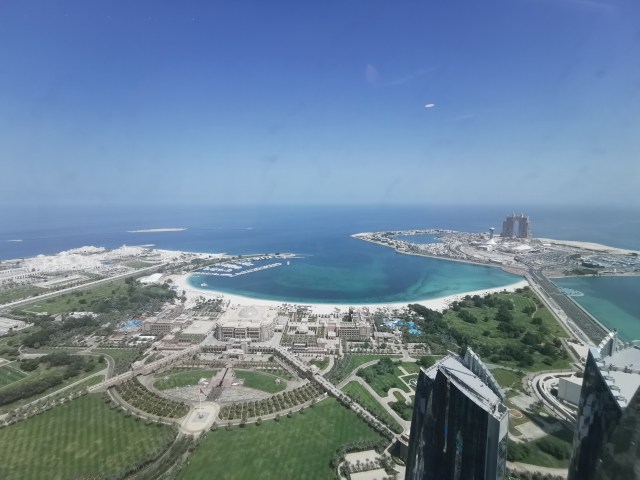


Our next stop was at the impressive Qasr Al Watan. This functioning presidential palace and a cultural place in Abu Dhabi, gave us a chance to learn more about the tradition that has defined the history of the UAE. The palace is also an architectural marvel and houses many beautiful artifacts and treasures.
Our third and final stop was at the Sheikh Zayed Grand Mosque, the largest mosque in the UAE.
However, before we had our final visit, we entered a shopping centre which was conveniently (and some may argue, slightly strangely) attached in part, to the mosque via a series of underground walkways.
Our guide made sure we found a restaurant to eat at and we enjoyed a meal of traditional Middle Eastern food. Following the meal, the women in the group were asked to put on the robes they had been given so they were dressed correctly for the mosque.
With Holly now suitably dressed, we were guided along the underground concourse from the shopping centre to the entrance of the mosque.
In front of us were huge white marble walls glistening in the bright sun and stunning minarets towering high into the sky. Then once inside, we saw the vast marbled halls, housing huge Swarovski crystal chandeliers as well as the largest hand-knotted carpet in the world.
After a full day of fun and sightseeing, and our legs feeling the effects of all the walking, we sat back and enjoyed our ride back to the hotel.

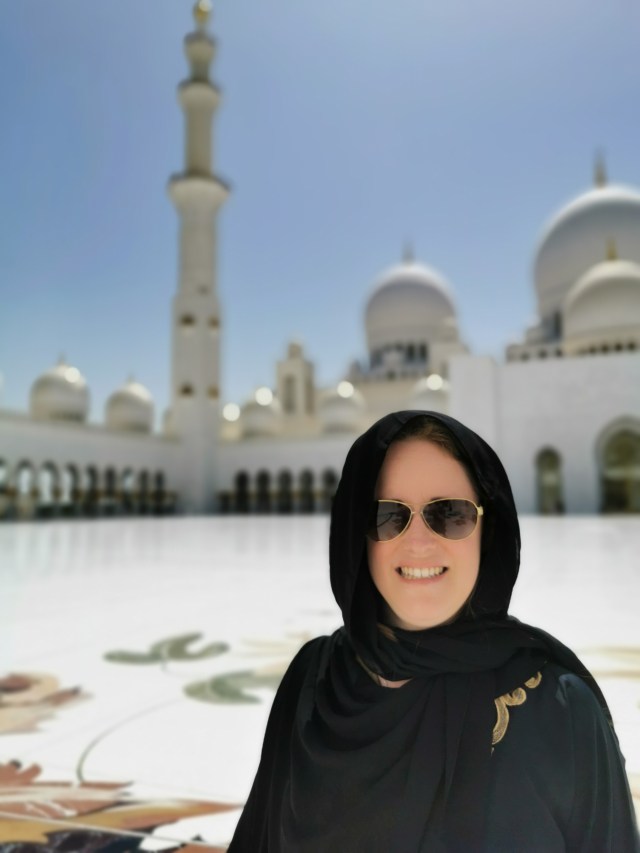

Where to avoid
First thing to point out is the Dubai, from our experience, was very safe. There were no places that we felt in danger and men and women walked comfortably on their own around the various parts of the city.
However, like any major city, crime does, of course, exist. It’s essential to keep your belongings on you as pick-pockets and opportunistic thieves will take advantage if you don’t. That’s a world-wide problem however, rather than one specific to Dubai.
So this section will look at a couple of attractions that can be missed if time is short.
One thing we were told check out during our trip to Dubai was the Gold Souk.
These traditional market places were described to us as a chance to get an authentic view of the real Dubai and the real United Arab Emirates. However, it’s hard to see that when you’re there.
Located at the north end of the city – in the Al Ras district just north of the Dubai Creek – the Gold Souk (and a variety of other souks selling all sorts of trinkets) is accessible via the Al Ras Metro station.
While the Gold Souks in Dubai boast an impressive range of gold and jewellery, one common concern is the authenticity of the products. It is essential to be cautious when purchasing from these markets, as counterfeit items can be found. Despite efforts by authorities to regulate the industry, some unscrupulous vendors may still sell fake or substandard gold.
Furthermore, while the Gold Souks present themselves as havens for gold enthusiasts and jewellery lovers, pricing discrepancies can often be a significant disappointment. While the markets may offer competitive rates compared to other regions, there is still a considerable variation in pricing within the souks themselves. Different vendors often quote vastly different prices for similar items, leading to confusion and uncertainty for buyers. Negotiation is a common practice, but it can be time-consuming and requires a strong haggling skill set.
Keeping these points in mind, we were went to the Souks with the intention of viewing them rather than buying from them. Arriving in the hot midday sun, we were expecting something like to see in the pictures from other countries. Lines of market sellers with the goods on the floor trying to entice you to part with your hard-earned money. Insread, it’s more like a walk down a standard shopping street.
The other downside is that the allure of the Gold Souks attracts a considerable number of visitors, resulting in overcrowded marketplaces. Navigating through the throngs of people can be a daunting task, especially during peak tourist seasons. Furthermore, some vendors employ aggressive sales tactics, constantly vying for customers’ attention and pressuring them into making purchases. This constant barrage can make the shopping experience overwhelming and detract from the enjoyment of exploring the market.
While we did go into one store and purchase (with a bit of amateur haggling) a small picture to take home, the general atmosphere and the set-up didn’t appeal.
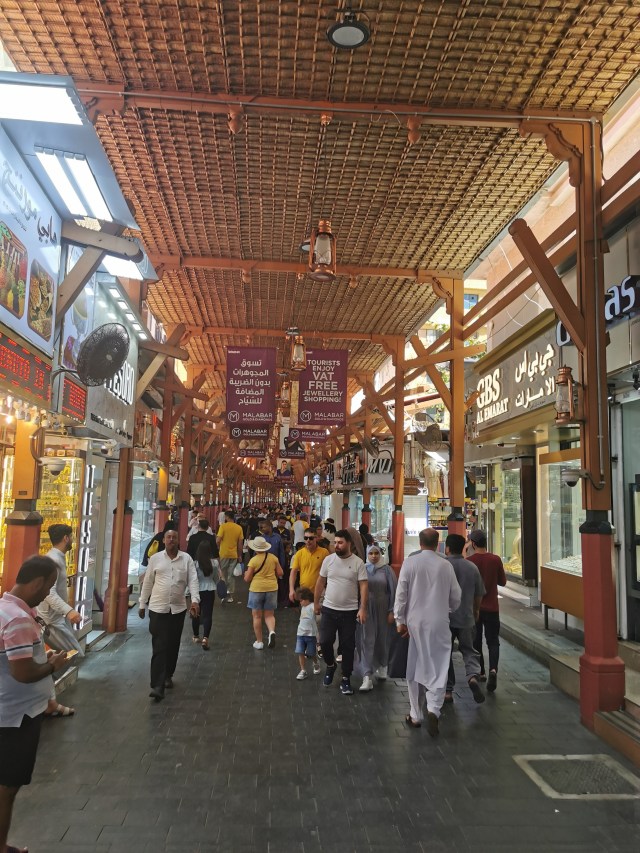
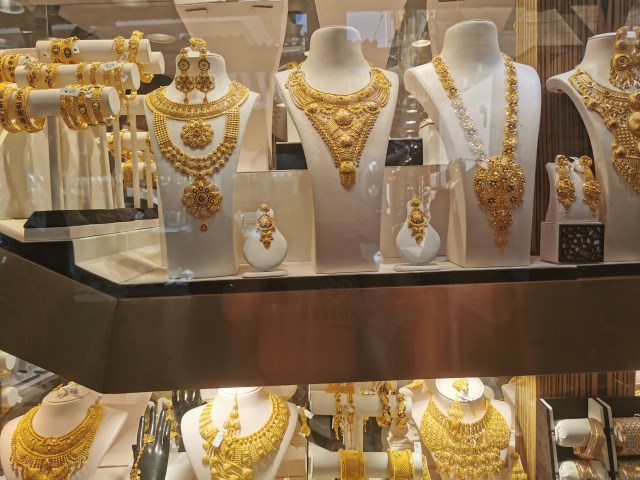

Also situated at the north end of the city (and just south of the Dubai Creek) is the Dubai Old Town.
Again, this was sold to us as a living history. A way to look at how life used to be in Dubai. However, the reality is, again, quite different.
Dubai Old Town, also known as Al Fahidi Historic District, is little more than a façade. It was built to recreate the charm of traditional Arabian architecture. Unfortunately, the area feels more like a manufactured theme park than an organic historical neighbourhood.
The buildings lack the genuine patina of age, with many being recently constructed replicas. The narrow, meandering streets, while visually appealing, are meticulously planned and lack the spontaneity and organic growth found in genuinely historic areas.
In its quest to appeal to tourists, Dubai Old Town has become more of a commercial hub than a genuine cultural district. The traditional houses, or wind towers, which were once authentic residences, have been transformed into art galleries, cafes, and shops selling tourist trinkets. This commercialisation dilutes the cultural heritage and turns the area into a tourist-centric zone, where authenticity takes a backseat to profit.
One of the greatest disappointments of Dubai Old Town is the lack of genuine local life. From our time there, the streets were pretty much dead! The district – as mentioned – is mainly frequented by tourists, with few actual residents remaining in the area. The absence of locals means that the opportunity to experience the vibrant daily routines, traditions, and cultural nuances that define a place is greatly diminished. Instead, visitors are left with a sanitised version of Dubai’s heritage.
While Dubai Old Town attempts to capture the essence of the city’s past, it pales in comparison to other historical sites around the world. Dubai, as we know it today, is a modern city that has experienced exponential growth and development over the past few decades. As a result, the historical significance of Dubai Old Town is relatively limited, especially when compared to other destinations that boast ancient ruins, UNESCO World Heritage sites, or centuries-old architecture.
So, while Dubai Old Town may hold promise as a cultural destination, it ultimately falls short of delivering an authentic and enriching experience.


Great places to eat
Dubai is an uber-modern city with a multitude of options for places to eat and drink.
I’ll be honest, during our time in the city we – for once – didn’t splash out on many restaurants; choosing instead to eat small snacks and meals; often on the go!
However, on our final night we decided to head somewhere special and fortunately the place we found was right across the road from our accommodation at the top of the neighbouring Marriott Harbour Hotel & Suites; the Observatory Bar & Grill.
Situated in the heart of Dubai Marina, this elevated dining destination not only serves delectable cuisine but also offers an awe-inspiring panoramic view of the city’s iconic skyline.
The décor has a sophisticated – if a little dark – charm. The venue’s sleek and contemporary style sets the stage for an great dining experience.
One of the most remarkable features of The Observatory Bar & Grill is its location on the 52nd floor. The moment you lay eyes on the floor-to-ceiling windows, you’re greeted with a captivating view of the Dubai Marina and Palm Jumeirah.
As Holly and I indulged in a sumptuous meal, the ever-changing panorama of the city unfolded before our eyes as the sun set, casting hues of orange and pink across the skyline.
The culinary offerings at The Observatory Bar & Grill are also pretty good. The menu features a fusion of international flavours and innovative culinary techniques. From succulent steaks and grilled seafood to vegetarian delights and tantalising desserts, the menu caters to a variety of tastes and preferences.
Meat lovers can enjoy a premium cut of steak, while seafood enthusiast have a fine choice from the freshest catches of the day, beautifully prepared and presented. For those seeking vegetarian options, the menu offers an array of creative dishes.
Our three course meal for two – as well as drinks cost us around 725 AED (around £156) and while this was an expensive choice, it rounded off our time in the middle east in perfect fashion.
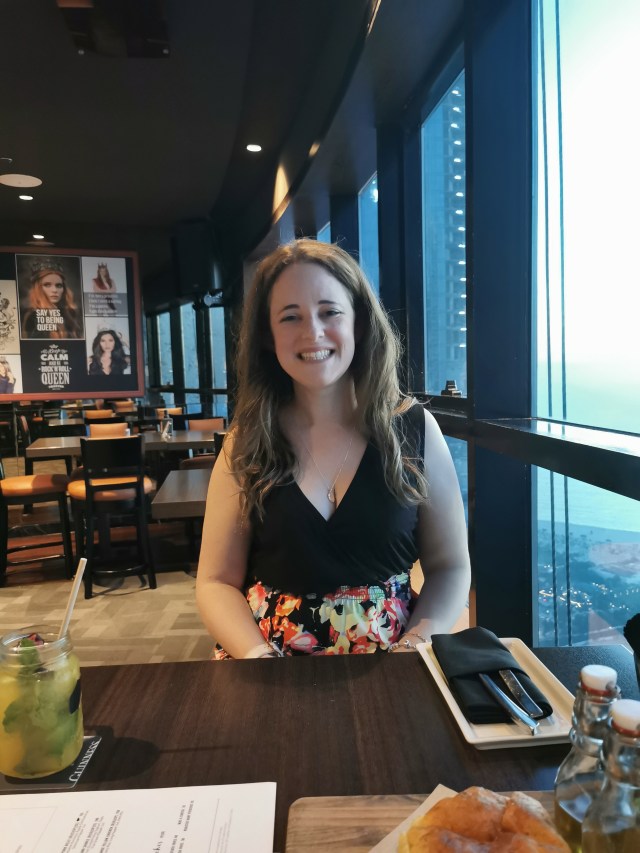
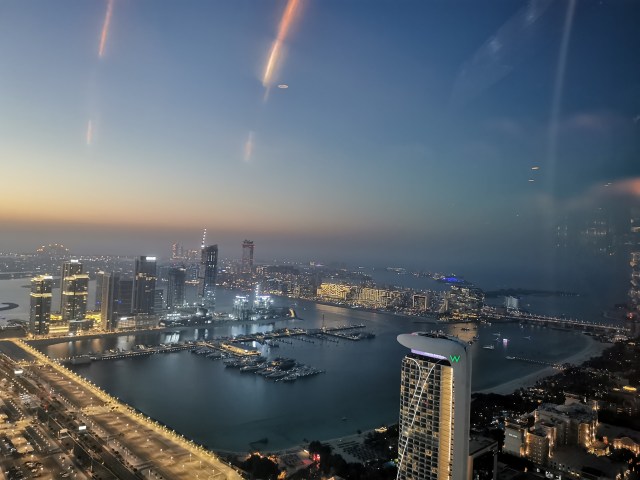

Useful links
Dubai Aquarium and Underwater Zoo
Atlantis Aquaventure Waterpark
Remember you can follow World Complete on Twitter, Instagram, Pintrest, Tumblr and Facebook send your comments and pictures from your travels using #WorldComplete and #Travel.

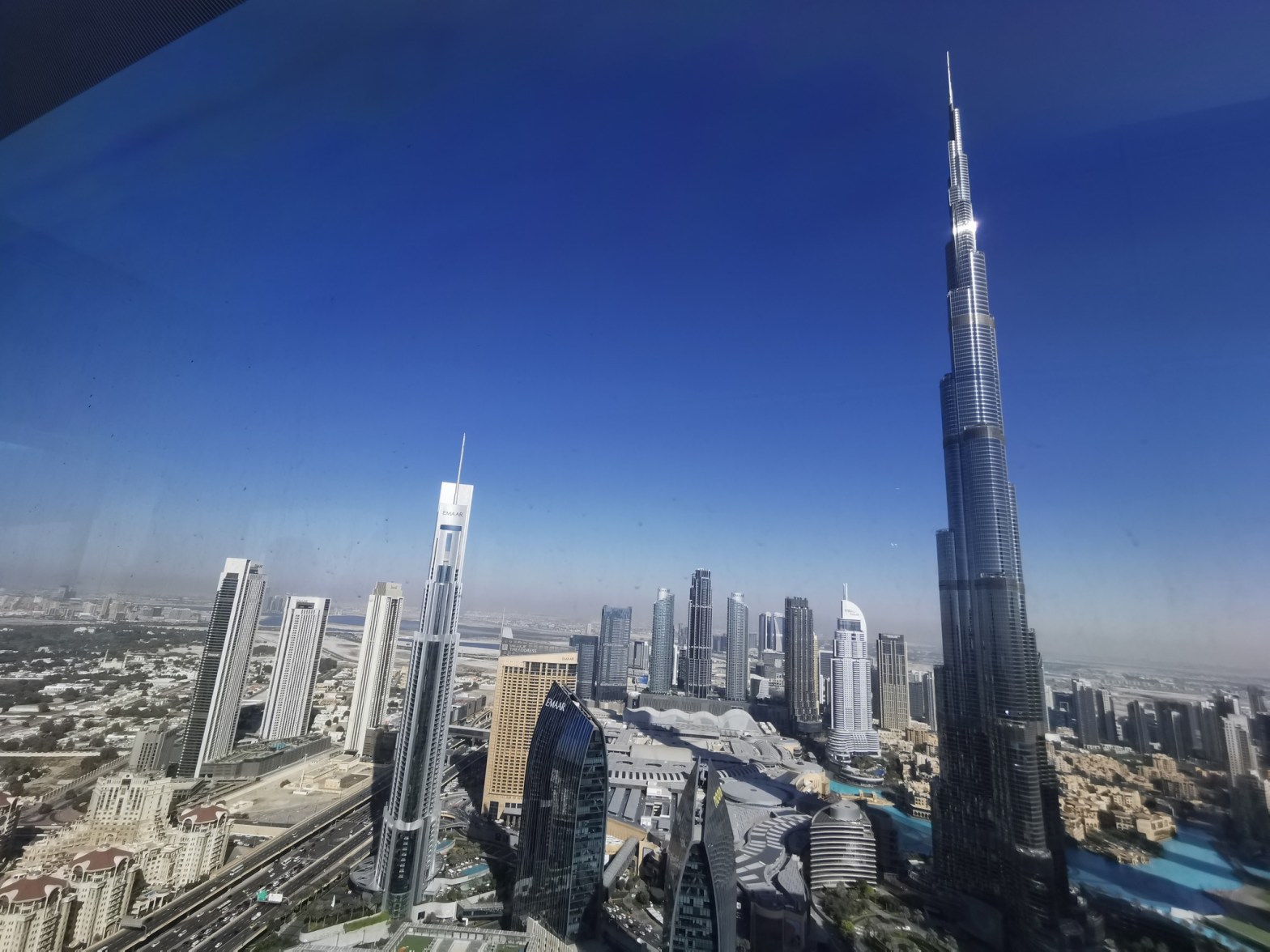
This was so interesting as we’re planning to visit for 5 days next February. We also play escape rooms whereever we go, and love the look of this wizard one 🙂
LikeLiked by 1 person
I’m glad you enjoyed the blog. Five days gives you a good amount of time to see the main bits of Dubai. Also good to hear you’re a fellow escape gamer. 😁 This one is good but if you’ve done them elsewhere it probably won’t be the best you’ve ever experienced. Still enjoyed playing it though.
LikeLiked by 1 person
We’ve done over 200 now just the 2 of us so we love any and all types of games. Actually prefer the less ‘staged’ ones…I hate when I have to jump through lasers and deal with live actors. Give me a combination code lock any day 😂
LikeLiked by 1 person
Amazing. I’m a novice at escape rooms compared to you. Only done around 80! 🙂 Agree with you though. Give me combination code locks over high tech
LikeLiked by 1 person
Very well done Steve. In addition to being entertaining, this post is a comprehensive travel guide for anyone planning a stop in Dubai. We only stopped for a few days, and could only scratch the surface, but you and Holly seem to have taken in all the big attractions, and it was interesting to see them presented in your post. I’m sure your post will be helpful for future visitors. All the best and congrats on your wedding. ~James
LikeLiked by 1 person
Thanks so much James. Glad you enjoyed the blog. We tried to cram as much in to the five days we were there as possible. And thank you for the kind words about our wedding. 🙂
LikeLike
I enjoyed reading your article on Dubai, the city aiming beyond the stars. You have captured the essence of this amazing city very well, with its blend of tradition and modernity, culture and innovation, luxury and adventure. I especially liked the photos you have included, they are stunning and show the diversity of Dubai’s attractions.
LikeLiked by 1 person
Thank you so much for the kind comments and I’m glad you enjoyed the blog. 🙂
LikeLike